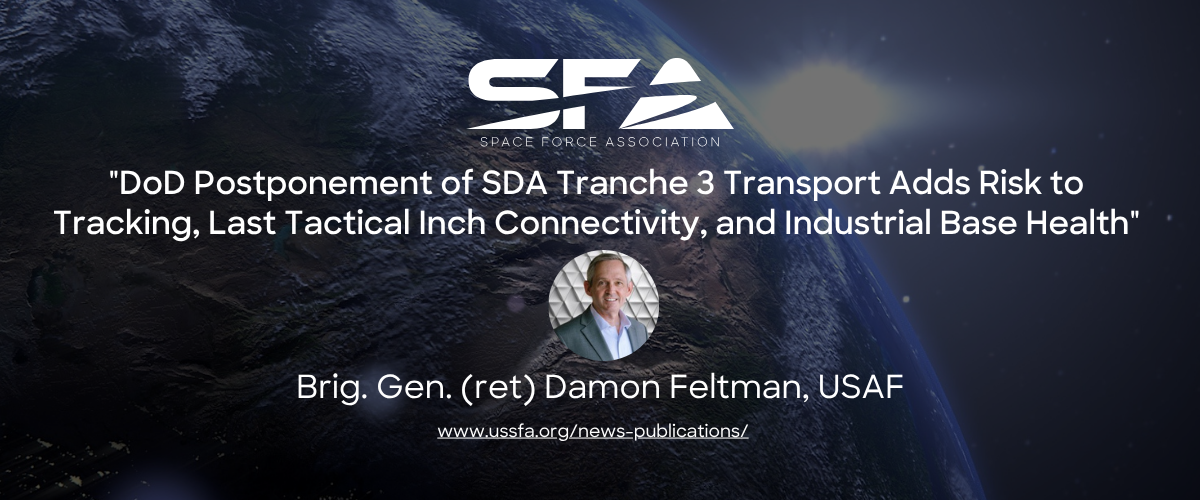Brig. Gen. (ret) Damon Feltman, USAF
The recent announcement by the Space Development Agency (SDA) that it is delaying the release of Requests for Proposals for its Tranche 3 Transport Layer satellites until it “receives budgetary guidance” is a disappointing and unnecessary setback for the Agency. Following other recent media reports on SpaceX being considered to perform the mission and the Office of Management and Budget’s January hit on SDA’s optical intersatellite link (OISL) progress, it appears the Department of Defense (DoD) may be seriously considering canceling or significantly redesigning this vital component of the Proliferated Warfighter Architecture (PWSA).
The Transport Layer is a widely misunderstood yet critical part of SDA’s architecture, even inside the Department of Defense. Directed delays, cancellations, or handing the program over to a commercial provider would be unwise on multiple levels.
To the casual observer, the Transport Layer might appear similar to other proliferated Low Earth Orbit (pLEO) SATCOM systems like SpaceX’s Starshield, but the differences are significant. While platforms like Starshield and Kuiper are designed for broadband internet-like connectivity, the Transport Layer is specifically designed for two vital non-commercial missions: delivering the Tracking Layer’s missile warning/missile track data to users, and providing “last tactical inch” connectivity directly to individual warfighters and platforms.
PWSA and variations of commercial pLEO SATCOM are not interchangeable. Specifically, this delay introduces three levels of unacceptable risk to the very warfighters the PWSA is set to serve.
First, the Tracking Layer is designed to work synergistically with the Transport Layer, much like a lock only works with the right key. Without Transport, delivery of missile warning data slows.
Both Tracking and Transport operate at the same orbital altitude, approximately 1,000 kilometers, which allows for efficiency of Tracking’s spacecraft design related to number and placement of OISLs. Tracking spacecraft are designed with three OISLs and are required to point in-plane and across-plane. There is no requirement for Tracking satellites to point OISLs downward towards lower orbits or the ground.
Meanwhile, Transport satellites have four OISLs and while these also point in- and across-plane, the OISLs also have a design requirement for downward pointing to Optical Ground Terminals (OGTs), aircraft, ships, and other ground mobile receivers. In addition, beginning in Tranche 3, select Transport satellites will also have a requirement to point up and connect to satellites at MEO altitudes.
In other words, if the DoD is considering replacing Transport with a commercial variant, it must consider that commercial platforms operate between 550 – 650 kilometers, well below the Tracking satellites. But because of the design requirements for Tracking Layer Tranches 1, 2, and 3, and the fact that Tranches 1 and 2 will already be flying when Tranche 3 is launched, the Tracking satellites’ OISLs might not be able to point to and connect with any satellite flying below it. Any commercial option would likely have to be specifically designed to fly at the same altitude as the Transport satellites it’s intended to replace in order to keep missile tracking data flowing as quickly as possible.
Next, in addition to being critical for delivery of timely missile warning data, the Transport Layer is optimized for extending connectivity and adding resiliency to unique existing tactical networks across existing hardware.
In Tranche 1, the Transport Layer will introduce the operationalization of Link-16 from space, instantly transforming this legacy multi-national, geographically-constrained tactical radio system into a global network. SDA has already borne the engineering risk to compensate for frequency doppler-shift from fast-moving satellites and done the tests to show it works. None of the 50,000+ existing Link-16 terminals in airplanes, ships, tanks, hand-held radios, and so on, will need modification. As part of the Tranche 3, the modernized Link-16 protected signal is planned.
Tranche 2 Transport will introduce two more tactical services – Integrated Broadcast Service from LEO (IBS-L) and TACSATCOM. In the case of IBS-L, SDA’s waveform design is on the modernization roadmap from the IBS Executive Agent, meaning receiver and terminal owners that follow the EAs plan will inherit IBS-L compatibility. Meanwhile, SDA continues to work with the TACSATCOM community as modernization plans are built to ensure Transport satellites are compatible with fielded terminals.
This is the genius of PWSA Transport – instant compatibility. If the world goes upside-down tonight, or any time in the next five years, the tactical fight will be executed over Link-16, IBS, and TACSATCOM, not Protected Tactical Waveform (PTW) or any other waveform in development today and waiting for its receivers to be integrated into 100,000 airplanes, ships, handsets, operations centers, and so on.
It is worth repeating two key points about Transport’s capabilities. First, in the case of Link-16, IBS-L, and TACSATCOM, currently fielded receivers, of which there are 10s of thousands in all the services and with allies, will either be fully compatible with Transport Layer as-is or via software updates. The days of fielding communications systems without matching terminals is over. Second, for each of these tactical links, SDA has already paid for the engineering, design, and testing to move these to pLEO at 1,000km. Doppler compensation is a significant challenge and it gets harder the lower the satellite flies. So, if the DoD chooses to move Tranche 3 Transport tactical links to a commercial variant, it will have to re-accomplish (pay twice for) the whole design life-cycle for each.
Finally, delay of Transport funding or movement to a commercial service significantly undercuts development of a robust space industrial base. SDA’s model of spiral development and Tranche awards every two years has simultaneously jump-started a new defense space economy and exposed weaknesses in the industrial base. SDA has been the proverbial canary in the coal mine and DoD budgeteers should be thanking SDA, not punishing the organization by pulling away this mission. These industrial base weaknesses are getting better and will continue to do so if SDA’s model is allowed to fully take root.
Furthermore, SDA’s success in developing standards and creating a market for OISLs has created efforts by commercial satellite vendors and DoD programs to add “SDA compatibility” to their designs. These commercial platforms cover multiple missions, from communications to remote sensing, and DoD missions add more. On its current path Tranche 3 Transport will likely become an in-space gateway for DoD users to access a network of networks.
As Congress debates FY26 appropriations, the “budgetary guidance” for SDA should be clear – continue with Tranche 3 Transport as planned.
About Brig. Gen. (ret) Damon Feltman, USAF:
Brig. Gen. (ret) Damon Feltman served more than 30 years in the Air Force. After retiring, he spent nearly two years at the Space Development Agency as the Chief of the Transport Cell, directing strategic initiatives for the $5.1 billion satellite communications network and driving innovation across 330+ satellites to enhance national defense capabilities. He is the founder of OXR Consulting, LLC.










